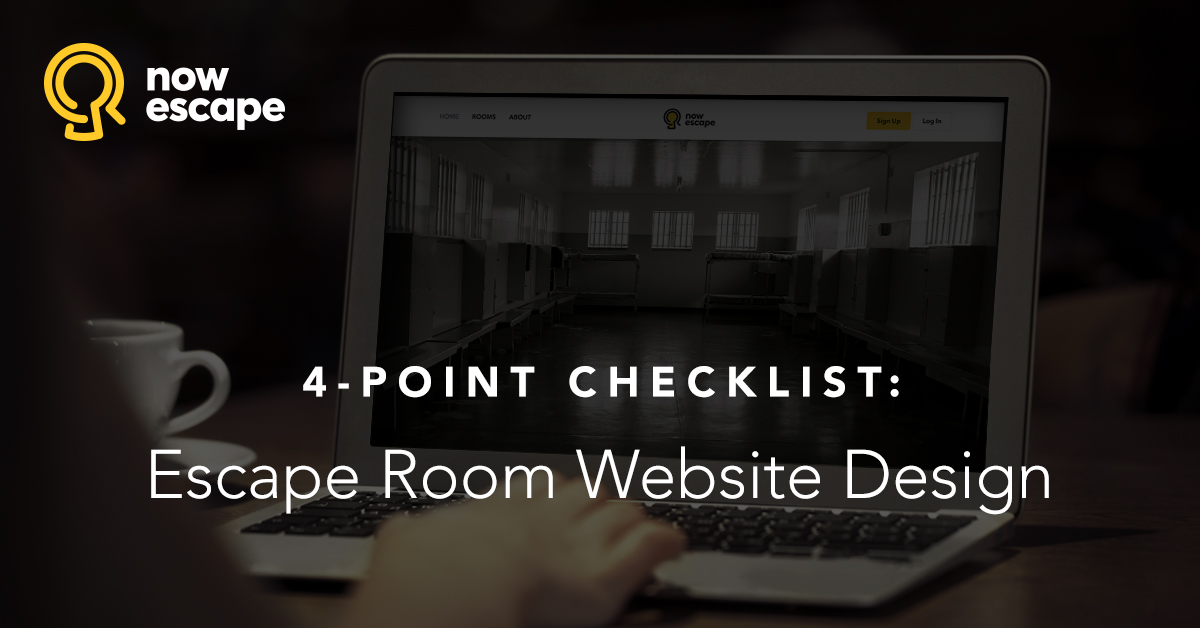
4-Point Checklist: Escape Room Website Design
First impressions are key – in life and in business.
For businesses today, that first impression is formed the moment a person looks at your website.
What is your potential customer’s first impression of your business?
Does this sound familiar?
You’ve opened you doors, and the local news outlets have done stories on your new business.
You’re getting good reviews from people who have experienced your room, so word-of-mouth traffic is good.
But you’re still not getting the online bookings you had been hoping for.
If this sounds like your experience, it’s time to analyze the effectiveness of your website.
Read on to find out how to design a website that makes a great first impression.

Your website is most people’s first impression of your business.
Your room designs and puzzles aren’t the only things being measured against your competition.
To convince people to try your games in the first place, you need to impress them before they ever set foot in your facility.
Great reviews and word of mouth will definitely help. But what about the people who come across your website via a Google search or an escape room directory?
When you design an escape room website, you’re doing a lot more than just creating an online booking destination.
Until they’ve seen your escape room(s) in person, all potential customers know about you is what your website tells them. And your website doesn’t communicate solely with words.
If your website looks unprofessional, is difficult to navigate, or fails to spark visitors’ imaginations, it’s unlikely to result in a booking. Your website must convince people your games are worth the price of admission.
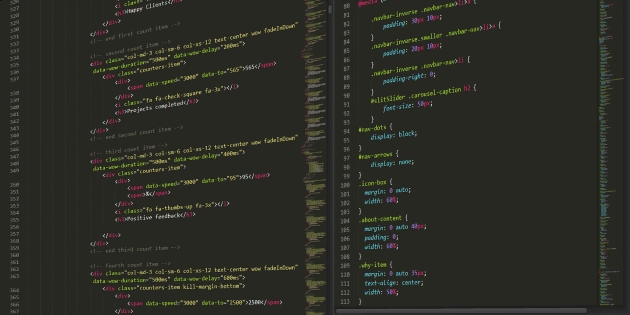
You don’t need a lot of computer skills to create an effective website.
Multiple factors go into good website design – so many factors that people actually get degrees in the field!
But you don’t necessarily need years of education to set up a simple and effective website when you’re just getting started. There are plenty of do-it-yourself platforms out there that give you all the tools you need to create a website with no HTML experience at all.
You also have the option of hiring an expert to design your site for you. However, even if you hire someone to design your site, you’ll still have to articulate to that person or firm what you want the site to look like and what you want it to say.
When you’re designing your website, the most important elements to consider are as follows:
- Your brand
- User experience
- Content (words and images)
- SEO
1. Your Escape Room Brand

Your brand tells the world who you are as a company.
Your brand is your identity. It’s who you are as a business. It’s your personality.
DON’T ignore the importance of creating a strong brand.
Everything that represents you to the public – from your logo to your website design to your signage and lobby decor to the way you answer the phone – is part of your brand.
DON’T mistake your room theme for your brand.
Your escape room business’s brand is not the same thing as the theme of your room. This will become painfully obvious if you start out with one room and later decide to expand!
DO think carefully about how you want your business to be perceived by the public.
Just as you might deliberately select clothing items that reflect your personality, the elements you use to represent your escape room company should tell the public who your business is.
DON’T try to be everything to all people.
Business owners often make the mistake of trying to create a brand that will appeal to everyone in the world out of fear of alienating potential customers.
The problem with this approach is that it leaves you with an image that is unmemorable and bland, thus alienating potential customers!
Your escape room business isn’t for everyone. It’s for a specific audience. And if you want that audience to respond to your website and marketing efforts, you need to demonstrate that you know who you are and why you’re special.
DO be imaginative and have fun developing your brand.
You can have rooms with many different themes, but your brand remains the same.
Are you looking to attract primarily adults, or do you want people to think of family entertainment when they think about your business?
Do you want to focus on the fun and laughter that customers experience when solving escape games, or would you rather highlight the mental challenges and countdown pressure?
Your escape room brand may be playful or spooky or quirky or cartoonish or steampunky or chilling or something else entirely.
It may be colorful and bright and fun like an amusement park, or it may be mysterious and shadowy like a detective novel.
It may be futuristic, or it may be trapped in the past.
It may be professional and businesslike, or it may be casual and relaxed.
Your imagination is the only limit to what your brand can be. Just make sure that once you define your brand, you remain consistent forever after.
2. User Experience

Make it easy for your visitors to find what they’re looking for.
Regardless of the choices you make in developing your brand, your website should be easy to interact with.
DON’T make your website visitors struggle to find what they’re looking for.
This cannot be stressed enough. The key information your website visitors need must be easy to find.
Some people who land on your website may be veteran escape game players. These people don’t need to be sold on the idea of playing an escape room. They already know what they’re looking for.
Veteran escape room enthusiasts are looking for the following:
- Descriptions of your rooms
- Your location
- Prices
- Your booking portal
Then there are the people who arrive at your website with little to no idea what an escape room is. These people need to be sold on the idea of playing an escape game before they’re ready for the details about your individual rooms, pricing, and booking information.
There’s also the chance that a third type of visitor – a manager looking for team-building activities – may find your website. If you offer special rates for corporate groups or expanded team-building training options, this person also needs to be able to quickly and easily find that information.
So, how do you make sure all of these potential customers are equally satisfied with the user experience on your website?
Well, it’s kind of like solving a puzzle.
Your site navigation needs to accommodate all three groups equally. You need to design pages and navigation in a way that anyone using your website can both:
- a) Instantly recognize the button or link he or she needs
- b) Navigate directly to that content without scrolling through a bunch of information that is not (or not yet) relevant
When testing your website, approach it as if you’re a member of each of these groups – or better yet, ask a neutral third party to test it for you from these perspectives.
Everything may seem logical and easy to find to you, but remember, you’re the one who put it there. If you’d never seen your website, would you find it easy to navigate?
DO make sure visitors can get anywhere on your website from anywhere on your website.
While we’re on the subject of navigation, don’t send your potential customers into a maze of dead ends. You should have no pages on your site that can only be exited by using the BACK button or abandoning the site entirely.
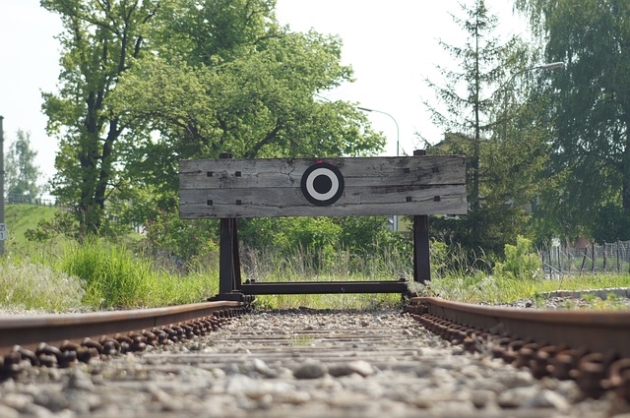
Avoid sending your visitors to a website dead end.
DON’T try to cram everything onto one page.
Before you start building your website, figure out what segments of information you want to cover and give each one a page.
At the very least, you’ll probably have the following pages:
- Home page – introduce your brand
- Room descriptions – sell your stories
- Pricing and policies – supply the fine print
- Booking – convert lookers into customers
- About – share your brand’s story, your location and directions, etc.
Some people include contact information on the “about” page, while others prefer to include a dedicated “contact” page; there is no right or wrong, as long as the information is available and clearly labeled.
DO optimize the photos on your website.
As an internet user, you know how frustrating it is to have to wait for a page to load. The larger your images are (in data size – not physical size), the longer it will take for visitors’ browsers to render them.
Fortunately, compressing images is easy. There are numerous free online tools you can use.
DON’T stuff your pages with text.

When people are reading a book, they expect the text to fill the page.
A webpage that contains margin-to-margin copy pretty much guarantees a swift exit.
Fill your pages with open space, short paragraphs, and clear, descriptive headers.
Imagine a person who can’t see paragraphs is skimming your page and ask yourself if he or she will get the key points solely from your images and headers.
DO make it easy to get to your booking platform from every page of your site.
Ultimately, the purpose of your website is to convert visitors into paying customers.
Some people may be ready to book as soon as they’ve read your room descriptions (more on that shortly). Others may wander around your site a bit before making a decision.
No matter where they are when that decision is made, visitors should be able to get to your booking platform with a single click or tap.
And once they get to your booking portal, the process should be effortless.
in Most Popular Escape Room Booking Systems.
3. Content
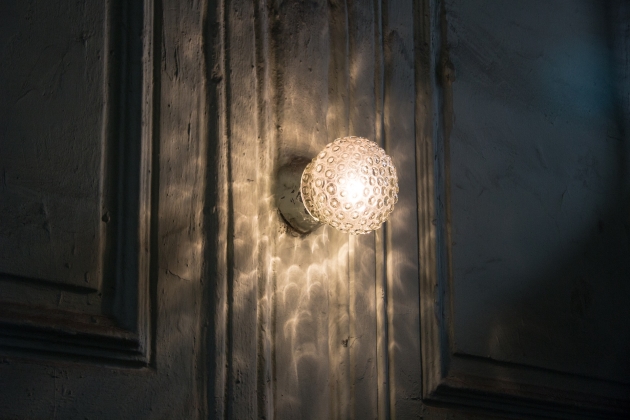
Draw your visitors in by appealing to their imaginations.
Once you know your visitors can find what they’re looking for and maneuver around your website without getting lost or running into dead ends, it’s time to focus on what they actually see when they visit your pages.
DO tell stories with your words.
People who play escape games are creative people.
They like the idea of entering another world and becoming part of the story.
So give them prose that stirs their imaginations.
Write room descriptions that reveal just enough to ignite their curiosity. Tell them where they’ll be, what they’ll be striving to do, and what the stakes will be if they fail.
Address all five senses.
Make them yearn to know how the story ends.
DON’T use words or pictures that don’t fit your brand.
Remember when you developed your business’s personality? Here’s where it becomes really important.
The colors, images, text, design elements, and ideas on your website should embody that personality 100 percent.
If your brand is playful and fun, the language you use should be light and humorous and delightful. Your images should pop with color and spark joy. Your entire website should say, “Come play with us!”
On the other hand, if your brand is mysterious, you’re going to avoid lighthearted, silly language and pictures. Your website should make the visitor feel as if he or she is following clues and discovering secrets.
Everything on every page of your website should wear your brand like a cloak.
DO include your full address on your website.
Include your full address – including your city, state or province, postal code, and country – at least in the footer of every page, so anyone who wants to know where you’re located can find it from anywhere on your site.
Remember, not everyone who arrives at your website is from your geographic area. Publishing only your street address is helpful for people who are local, but they’re not your only potential customers.
It’s also helpful to include a map and directions to your facility on at least your “About” page. Another good place to include this information is the “Booking” page.
DON’T use low-quality photos.
Your best bet is to use photos you (or someone you hired) took. This will guarantee that the images on your site won’t be found on any other escape room websites.
Using your own photography also allows you to do the same thing with your images that you did with your words – inspire your potential customers to dream about what’s behind those doors!
It should go without saying that you should use an actual camera to take your photos – not your phone.
If you don’t have the time, skill, or patience to take your own high-quality photos, you’ll need to use stock photography.
There are tons of stock photo sites out there. Some are free. Some charge a flat fee for unlimited downloads over a specific time period. Some charge per downloaded photo. It’s up to you and your budget which way you wish to go.
Generally, the paid sites offer a greater selection and higher quality images.
DO proofread your copy.
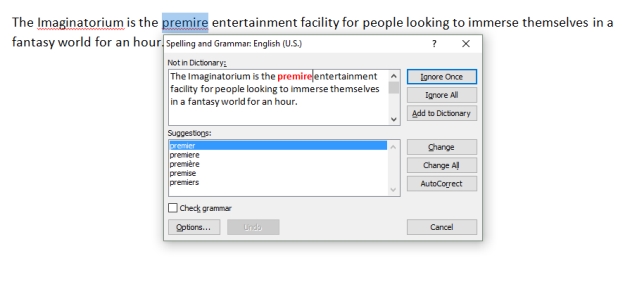
Don’t let spelling and grammar errors ruin your first impression.
This should also go without saying, but you’d be surprised how many people publish content on their websites that’s filled with spelling and grammatical errors.
Remember, your website is generally a potential customer’s first impression of your brand and your business.
Whether they consciously mean to or not, readers are likely to conclude that if you didn’t take the time to correct errors in your website copy, you might have put the same lack of effort into your escape rooms.
DON’T use low-budget videos.
You may have heard that videos are a must when it comes to marketing your business.
It’s true that including a video on your site can dramatically improve your conversion rate. But that only applies if your video is polished and professional.
It is more harmful to your brand’s image to include a video with low production values than it is to have no video at all.
4. SEO

Make sure people can find your website in their search results.
Finally, you want to make sure that your website plays well with search engines.
DO include relevant keywords throughout your site.
Make sure the text on all your pages includes variations of phrases like live escape room, escape game, room escape, and exit game.
In particular, use keywords in headers and page titles.
DON’T use generic page titles.
The page title is the text that shows up in the tab at the top of the viewer’s browser. You can put anything you want in that field – it doesn’t have to match the header on the page. So slip some keywords in there and make it descriptive.
DO optimize your images.
Yes. We mentioned this when we talked about user experience.
But there’s another reason to optimize your images besides just making your visitors happy.
Search engines include a website’s load time in their ranking algorithms. The faster your site loads, the more likely it is to be moved up in search engine rankings, which means the higher it appears in the results.
in SEO Tools for Escape Room Owners.
Conclusion
It might seem like a lot of work – and it is – but taking the time to carefully think through your brand identity and web design will make your escape room business stand out among all the others.
- DO focus on creating a unique and memorable brand.
- DO consistently apply the elements of your brand to all your marketing efforts.
- DO make it easy for both escape room veterans and newbies to navigate directly to the information they need.
- DO use unique, sensory words and images that tell stories and spark the imagination.
- DO proofread your entire site and use only high quality photos and videos.
- DO follow basic SEO practices to increase your search engine visibility and site traffic.
Follow these tips, and you’ll be on your way to creating a first impression that inspires people to trust your brand and give your escape room(s) a try.
Designing an effective website is just one of the many steps to starting or enhancing your escape room business.
If you’re just getting started, you’ll find a step-by-step guide in our blog, How to Open Your Own Escape Room: A Simple 22-Step Guide.
For additional resources, check out Nowescape’s Resources Directory.
Nowescape also offers the industry’s only booking system designed specifically for escape rooms. Find out more.





1 Comment
Wow solid article Kristin/Fred. Can’t agree more on not basing your brand on your 1st escape room. No business *ever* stays the same through the years of changing times.
If I may add a few additional tips:
– Add your phone number somewhere totally obvious on the website. Yes, people are annoying. I get that. But people spend money and some people just want to talk to someone.
– Don’t use a plain black background as this looks very ’90’s. Instead, grab a texture or just do something totally different.
– Proofreading tip is to use a text to speech converter to read your article back to you. I’m *super* bad at all things proofreading and have been known to misspell the actual heading… On a Mac do this via System Preferences -> Accessibility -> Speech
– Technical: most your customers will find you on a phone so your page loading fast is really important. Find someone who can connect your website to a Content Delivery Network (CDN). This means your website will exist is really stylish homes, all over the world, and will probably half your page load time. If you’re using Wix/Squarespace don’t worry they’re already doing this for you.
Super great article – definitely sharing!